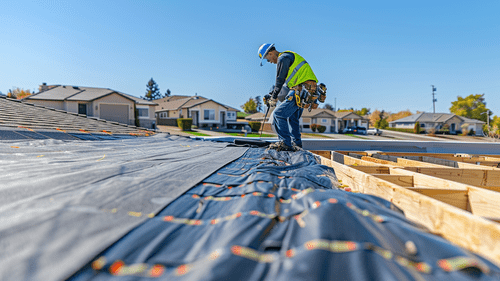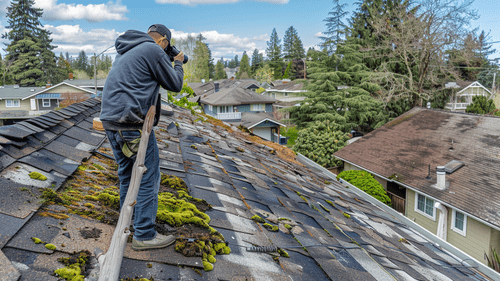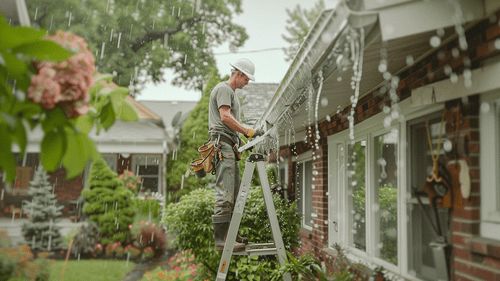Your roof quietly protects your home every day, but how often do you return the favor? Most homeowners discover roof problems only after water starts dripping through the ceiling—when minor issues have already grown into expensive repairs. What if a few hours of attention each season could add 5-10 years to your roof's life and save you thousands in unexpected costs? The difference between a 15-year and a 25-year roof often comes down to something surprisingly simple: regular maintenance.
Each season brings unique challenges to your roofing system—from winter's ice dams to summer's scorching UV rays. This yearly maintenance checklist breaks down exactly what your roof needs and when it needs it, with specific steps for spring revival, summer protection, fall preparation, and winter vigilance. We've included professional techniques for everything from proper gutter cleaning to safe snow removal, plus warning signs you can spot from inside your home. By following this seasonal approach, you'll not only extend your roof's lifespan but also gain peace of mind knowing you've protected one of your home's most valuable assets.
Spring Revival: Post-Winter Recovery for Your Roof
The transition from winter to spring marks a critical time for roof maintenance. After enduring months of freezing temperatures, snow loads, and winter storms, your roof needs special attention to recover properly. A thorough spring assessment sets the foundation for year-round protection and helps identify damage before it escalates into costly repairs.
Begin your spring roof maintenance with a comprehensive visual inspection from the ground using binoculars. Look for obvious signs of winter damage such as missing, cracked, or curled shingles. Pay particular attention to areas around chimneys, vents, and skylights where flashing may have been compromised by winter's freeze-thaw cycles. These transition points are especially vulnerable to water intrusion and often show the first signs of failure after harsh winter conditions.
Winter's aftermath often leaves gutters clogged with debris, preventing proper drainage when spring rains arrive. Start by removing large debris by hand (wearing protective gloves), then flush the entire system with a garden hose to clear smaller particles. Watch for proper water flow and check for leaks at seams and corners. Properly functioning gutters are essential for directing water away from your roof and foundation—when they're clogged, water can back up under shingles and create the perfect environment for rot and mold growth. Also inspect gutter fasteners and ensure they remain securely attached to the fascia board, as winter's weight from ice and snow can loosen these critical connections.
Addressing Winter Damage and Ventilation Issues
Shingle damage from winter storms requires immediate attention before spring rains create further problems. Look specifically for granule loss (check gutters for excessive granule accumulation), which indicates advanced shingle wear. Ice dams—those picturesque but destructive ridges of ice that form at roof edges—often leave telltale damage in their wake. Examine the lower portions of your roof carefully for signs of lifted shingles or water staining, particularly in areas where ice dams were visible during winter months.
Proper ventilation is crucial as temperatures begin to rise. During winter, many homeowners inadvertently reduce airflow to conserve heat, but this can trap moisture in the attic space. Inspect both intake vents (typically in the soffit) and exhaust vents (ridge or gable vents) to ensure they're clear of debris and functioning properly. A well-ventilated roof system allows air to circulate freely, preventing moisture buildup that leads to mold growth and wood rot. It also helps regulate temperature, extending shingle life by preventing excessive heat buildup as summer approaches.
The damp conditions of early spring create the perfect environment for biological growth on your roof. Conduct a careful inspection for signs of mold, algae, or moss—particularly on north-facing roof sections that receive less sunlight. These organisms do more than create unsightly discoloration; they actively retain moisture against your roofing materials, accelerating deterioration and potentially creating entry points for water. For minor cases, a mixture of water and bleach (in a 4:1 ratio) can be effective, but avoid pressure washing, which can damage shingles by dislodging protective granules. For extensive growth, consider professional cleaning services that use appropriate low-pressure methods and environmentally friendly cleaning solutions.
Summer Protection: Safeguarding Against Heat and Storms
Summer brings unique challenges to your roofing system, with intense UV radiation and sudden, powerful storms threatening its integrity. The combination of extreme heat and occasional heavy rainfall creates stress that requires specific preventative measures to ensure long-term protection.
Ultraviolet radiation represents one of summer's most persistent threats to roofing materials. Over time, UV exposure breaks down the oils in asphalt shingles, causing them to become brittle and lose flexibility. This deterioration manifests first as granule loss, which accelerates the aging process by exposing more of the shingle to direct sunlight. During summer inspections, look for shingles that appear lighter in color than surrounding areas—this often indicates advanced UV damage. While you can't prevent UV exposure entirely, identifying problem areas early allows for targeted repairs before more extensive damage occurs. Some roofing materials offer better UV resistance than others, so consider this factor when planning future roof replacements.
Managing attic temperature becomes particularly important during summer months. Without proper insulation and ventilation, attic spaces can reach temperatures exceeding 150°F, creating a heat transfer effect that damages shingles from beneath while increasing cooling costs. Check that attic insulation maintains the recommended R-value for your climate zone (typically R-38 to R-60 for most regions), ensuring it's distributed evenly without compressing or blocking soffit vents. A properly insulated attic with functioning ventilation creates a thermal barrier between your living space and roof, protecting both from extreme temperature fluctuations.
Preparing for Summer Storms and Tree Management
Summer storms arrive with little warning, bringing high winds, heavy rain, and sometimes hail. Prepare by securing any loose roofing materials during your early summer inspection. Pay special attention to the roof's edges and ridges, where wind can more easily lift shingles. For homes in particularly storm-prone areas, consider whether your current roofing system includes enhanced wind resistance features such as six-nail patterns instead of the standard four-nail approach. Also inspect all flashing (the metal pieces that cover joints in roof construction) to ensure they're securely fastened and sealed properly to prevent water intrusion during heavy downpours.
Trees surrounding your home require careful management before storm season peaks. Trim branches that hang over your roof, maintaining a minimum clearance of 10 feet. This prevents both immediate damage during storms and the ongoing abrasion that occurs when branches repeatedly brush against roofing materials. Additionally, overhanging branches drop leaves and needles that retain moisture against your roof's surface, accelerating decomposition and creating ideal conditions for moss growth. When trimming, also remove dead or diseased limbs that could become dangerous projectiles during high winds, potentially causing significant impact damage to your roof.
Flashing inspection deserves special attention during summer maintenance. These metal components create waterproof seals around roof penetrations and transitions, including chimneys, vents, skylights, and valleys. Summer's heat can cause expansion and contraction that stresses sealants and creates gaps where water can enter during sudden downpours. Examine all flashing for signs of lifting, corrosion, or failed sealant. Pay particular attention to step flashing along walls, chimney flashing, and valley flashing where two roof planes meet—these areas channel large volumes of water during heavy rains and represent common failure points in roofing systems. Reseal any compromised areas with appropriate roofing cement or replace flashing sections that show significant deterioration.
Fall Preparation: Getting Ahead of Winter Challenges
Fall represents your last opportunity to prepare your roof for winter's harsh conditions. This transitional season requires thorough preparation to ensure your roofing system can withstand the coming months of snow, ice, and freezing temperatures. A proactive approach during autumn can prevent many common winter roofing emergencies.
Gutters require especially thorough attention during fall as trees shed their foliage. Beyond the basic cleaning most homeowners perform, proper gutter maintenance includes several often-overlooked steps. First, after removing debris, check the pitch of gutters to ensure they maintain the recommended slope of ¼ inch per 10 feet toward downspouts. Improper pitch allows water to pool, creating weight that can pull gutters away from the fascia. Second, confirm that downspouts extend at least 5-10 feet from your foundation to prevent water damage. Finally, consider installing gutter guards if your property has many trees—while not maintenance-free, quality guards significantly reduce cleaning frequency and prevent the complete blockages that lead to ice dams and water backup.
- Advanced gutter cleaning techniques:
- Use a plastic scoop rather than metal tools to prevent gutter scratching
- Flush gutters with water after debris removal to identify leaks and check flow
- Clean downspout strainers and check for clogs using a plumber's snake if necessary
- Tighten gutter hangers and replace any that show significant corrosion
- Apply silicone sealant to leaking seams and joints after thoroughly drying the area
Roof surface clearing extends beyond gutters to include the entire roofing system. Fall debris tends to collect in valleys, around chimneys, and behind any roof protrusions. These accumulated materials trap moisture against roofing materials, accelerating deterioration and potentially creating entry points for water. Use a soft-bristled brush or leaf blower (never pressure washers) to clear these areas, working from the top down to avoid forcing debris under shingles. Pay particular attention to areas where different roof planes meet, as these natural collection points channel significant water during winter thaws and spring rains.
Preventing Moisture Issues and Preparing for Winter Heating
Moss and lichen pose significant threats to roofing materials, especially before winter. Unlike algae, which primarily causes aesthetic concerns, moss and lichen are three-dimensional organisms that can lift shingles and trap moisture against the roof surface. Fall represents the ideal time for removal before freezing temperatures make treatment less effective. For light infestations, a 50/50 mixture of water and white vinegar applied on a dry, overcast day can be effective. For established growth, zinc or copper strips installed near the ridge can create a natural biocide that washes down the roof during rainfall. Remember that physical removal methods like scraping can damage shingles, so use gentle approaches and consider professional treatment for extensive problems.
Proper attic insulation plays a crucial role in preventing ice dams—those destructive ridges of ice that form at roof edges during winter. Fall is the ideal time to assess your insulation levels and address any deficiencies. The goal is to maintain a consistent roof temperature by preventing indoor heat from escaping through the attic. Check for adequate R-value (typically R-38 to R-60 depending on your climate zone) and ensure even distribution without compressed areas. Pay particular attention to sealing attic bypasses—gaps around pipes, ducts, and fixtures that allow warm air to escape into the attic space. These heat leaks create localized warm spots on the roof that melt snow, which then refreezes at the colder eave edge, forming destructive ice dams.
Chimney and vent inspections become particularly important before heating season begins. Start by checking the chimney cap and screening for damage that might allow animals or debris entry. Examine the mortar joints between bricks for cracking or deterioration that could allow water penetration during freeze-thaw cycles. The flashing where the chimney meets the roof requires careful inspection for gaps, rust, or failed sealant. For all roof vents, confirm that the boots (the flexible material sealing around pipes) remain intact without cracking or pulling away from the pipe. These seemingly minor components play a major role in keeping water out of your home during winter storms and spring thaws. Addressing deficiencies before winter arrives prevents more serious damage that would be difficult to repair during cold weather.
Winter Vigilance: Monitoring and Emergency Protocols
Winter presents unique challenges for roof maintenance, requiring vigilance and preparation rather than extensive hands-on work. The combination of snow loads, ice formation, and freeze-thaw cycles creates stresses that can quickly damage even well-maintained roofing systems if not properly monitored and addressed.
Snow removal becomes necessary when accumulation exceeds the design capacity of your roof. Most residential roofs can safely support 20-25 pounds per square foot, which translates to approximately 4 feet of fresh snow or 2 feet of old, compressed snow. Rather than climbing onto a slippery roof, use a roof rake with an extended handle to remove snow from the edges (about 3-4 feet up from the gutters) while standing safely on the ground. This approach prevents ice dam formation by removing snow from the coldest part of the roof while leaving a protective layer on the main surface. When using a roof rake, work horizontally across the roof rather than vertically to avoid pulling snow onto yourself, and avoid scraping all the way to the shingle surface, which could damage the roofing materials.
Ice dam prevention requires a multi-faceted approach beyond basic snow removal. While proper insulation and ventilation represent the best long-term solutions, several immediate strategies can help during winter months. Consider installing heating cables in a zigzag pattern near the roof edge, which provide channels for meltwater to escape rather than backing up under shingles. For immediate relief when ice dams have already formed, fill a nylon stocking with calcium chloride ice melt (never rock salt, which damages shingles) and lay it perpendicular to the ice dam. This creates a melt channel through the dam, allowing trapped water to escape. Remember that these are temporary solutions—addressing the underlying causes through proper insulation and ventilation should be prioritized once weather permits.
Emergency Response and Indoor Warning Signs
Creating an emergency response plan before winter problems occur can prevent minor issues from escalating into major damage. Start by identifying qualified roofing contractors who offer emergency winter services, saving their contact information in an accessible location. Prepare a temporary interior catch system using buckets, plastic sheeting, and towels to minimize water damage if leaks develop. For accessible areas where ice dams have caused water backup, consider using a box fan in the attic to freeze the water before it penetrates further into your home—this buys time until professional help arrives. Also maintain basic supplies including roof-safe ice melt, a roof rake, tarps, and battery-powered lighting in case winter roof emergencies coincide with power outages.
Monitoring snow load without climbing onto your roof requires attention to several indicators. Listen for unusual creaking or popping sounds from the roof structure, which may signal excessive weight. Watch for doors that suddenly stick or interior cracks that appear in drywall, particularly around door frames—these often indicate structural movement under snow weight. For a more objective assessment, measure snow depth on the ground and multiply by the appropriate factor based on snow type (about 0.15 for light, fluffy snow and 0.3 for heavy, wet snow) to estimate the pounds per square foot on your roof. This calculation provides a rough guide for when snow removal becomes necessary.
Indoor warning signs often provide the first indication of winter roof problems. Water stains on ceilings or walls, particularly near exterior walls or in upstairs rooms, typically indicate ice dam formation or roof leaks. Excessive moisture in the attic, visible as condensation on nails or sheathing, suggests ventilation problems that require attention. Sudden increases in heating costs without temperature changes often indicate heat escaping through the roof due to insulation failures or ice dam formation. Even subtle signs like unusual drafts in upper rooms or visible daylight through the roof boards in the attic warrant immediate investigation. By recognizing these indoor indicators early, you can address developing issues before they cause significant structural damage or require complete roof replacement.
Creating Your Personalized Roof Maintenance Calendar
A systematic approach to roof maintenance ensures no critical tasks are overlooked throughout the year. Creating a personalized maintenance calendar tailored to your specific roofing materials and local climate conditions transforms overwhelming maintenance requirements into manageable, scheduled activities.
Different roofing materials demand distinct maintenance approaches and schedules. Asphalt shingles, the most common residential roofing material, typically require inspection after severe weather events and seasonal checks for granule loss, curling, and cracking. Metal roofing, while generally more durable, needs examination for loose fasteners, surface scratches that might lead to corrosion, and sealant deterioration at seams. Tile and slate roofs demand professional inspection due to their fragility when walked upon, with focus on cracked or slipped individual pieces. Wood shakes require more frequent maintenance with special attention to moss growth and moisture retention. When creating your maintenance calendar, research the specific requirements of your roofing material and incorporate manufacturer recommendations, which often include maintenance steps necessary to maintain warranty coverage.
Assembling the right tools for DIY maintenance saves time and prevents improvised approaches that might damage roofing materials. Basic equipment should include binoculars for ground-based inspection, a sturdy extension ladder with stabilizers, soft-bristled brushes for debris removal, a garden hose with spray nozzle for gutter flushing, and appropriate safety gear including non-slip shoes and gloves. For specialized tasks, consider investing in a gutter scoop, roof rake for winter snow removal, and moisture meter to check for hidden water damage. However, recognize your limitations—tasks requiring walking on the roof, extensive repairs, or work around electrical lines should be left to professionals. Your maintenance calendar should clearly distinguish between DIY tasks and those requiring professional services, with contact information for trusted contractors readily available.
Documenting your maintenance activities provides valuable historical information and often proves essential for warranty claims. Create a simple but comprehensive system recording the date, specific maintenance performed, any issues identified, and repairs completed. Include photographs of problem areas before and after repairs, receipts for professional services, and product information for any materials used. This documentation demonstrates your diligence in roof care should warranty claims become necessary, as most manufacturers require proof of regular maintenance to honor coverage terms. Store these records both digitally (cloud storage) and physically (home documentation binder) to ensure accessibility when needed.
Financial Planning and Technology Integration
Budget planning for roof maintenance prevents financial surprises and ensures necessary work isn't deferred due to cost concerns. Establish a dedicated roof maintenance fund with regular contributions based on your roof's age, material, and condition. For newer roofs, allocating $150-300 annually for routine maintenance and minor repairs provides adequate coverage for most homes. As roofs age beyond the 10-year mark, consider increasing this amount to $300-500 to address more frequent repair needs. This proactive financial approach transforms unexpected roofing emergencies into planned expenditures, reducing financial stress while extending your roof's service life through consistent care. Remember that every dollar spent on preventative maintenance typically saves $4-5 in future repair costs.
Technology offers valuable tools for maintaining your roof maintenance schedule. Numerous home maintenance apps provide customizable reminder systems that align with seasonal requirements. Weather alert applications can prompt additional inspections after severe storms when damage is most likely. Some advanced options even allow you to create virtual models of your roof, documenting problem areas with geo-tagged photos that help track issues over time. For those with limited mobility or comfort with heights, consider drone inspection services that provide detailed roof imagery without requiring ladder access. These technological approaches complement traditional maintenance practices, ensuring consistency while reducing the likelihood that critical tasks will be overlooked.
Adapting your maintenance calendar to changing conditions ensures its continued relevance. Review and adjust your schedule annually, incorporating lessons learned from the previous year's experiences. If certain seasonal tasks consistently reveal problems, consider increasing their frequency or adding preliminary checks. For instance, if fall gutter cleaning always reveals excessive debris, add a mid-summer cleaning to prevent buildup. Similarly, if spring inspections routinely uncover winter damage in specific areas, add targeted mid-winter monitoring of those vulnerable sections. This iterative approach transforms your maintenance calendar into an increasingly effective tool tailored specifically to your home's needs, reflecting both the unique characteristics of your roofing system and the particular challenges presented by your local climate conditions.
Conclusion: Your Roof's Lifetime Partner—You
Your roof silently protects your most valuable asset every day, asking little in return except for a few hours of seasonal attention. The difference between replacing your roof after just 15 years or enjoying 25+ years of protection isn't luck—it's the commitment to following a structured maintenance routine that addresses each season's unique challenges. From spring's post-winter revival to winter's vigilant monitoring, this proactive approach transforms overwhelming roof care into manageable, scheduled activities that protect your investment while providing peace of mind during severe weather.
Remember that every hour spent maintaining your roof can save thousands in premature replacement costs and prevent the cascading damage that occurs when small problems grow unchecked. Your roof doesn't need constant attention—just consistent care at the right times. The next time rain falls or snow blankets your home, you'll rest easier knowing you've done everything possible to maintain the critical barrier between your family and the elements. After all, your roof protects you without complaint 24/7—doesn't it deserve the same loyalty in return?







